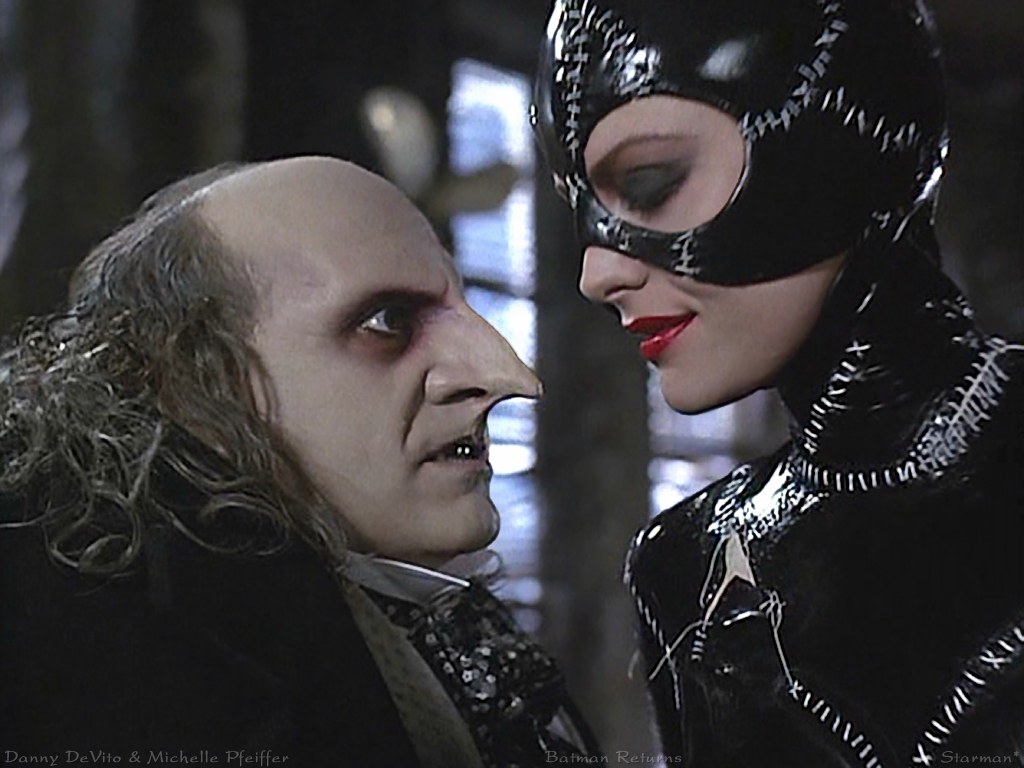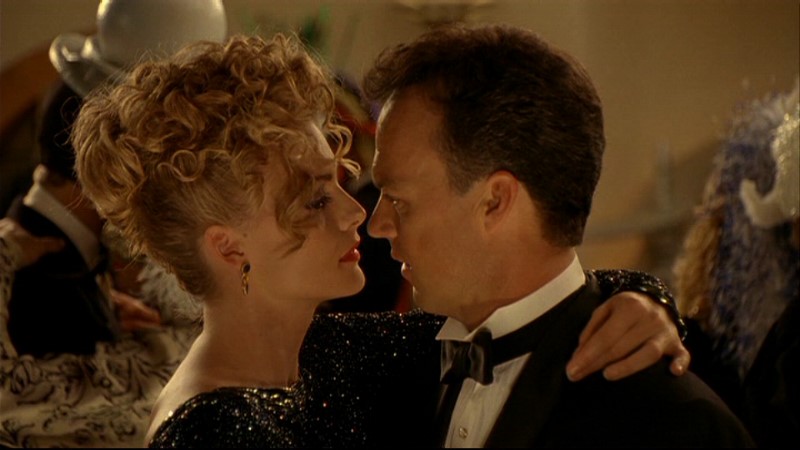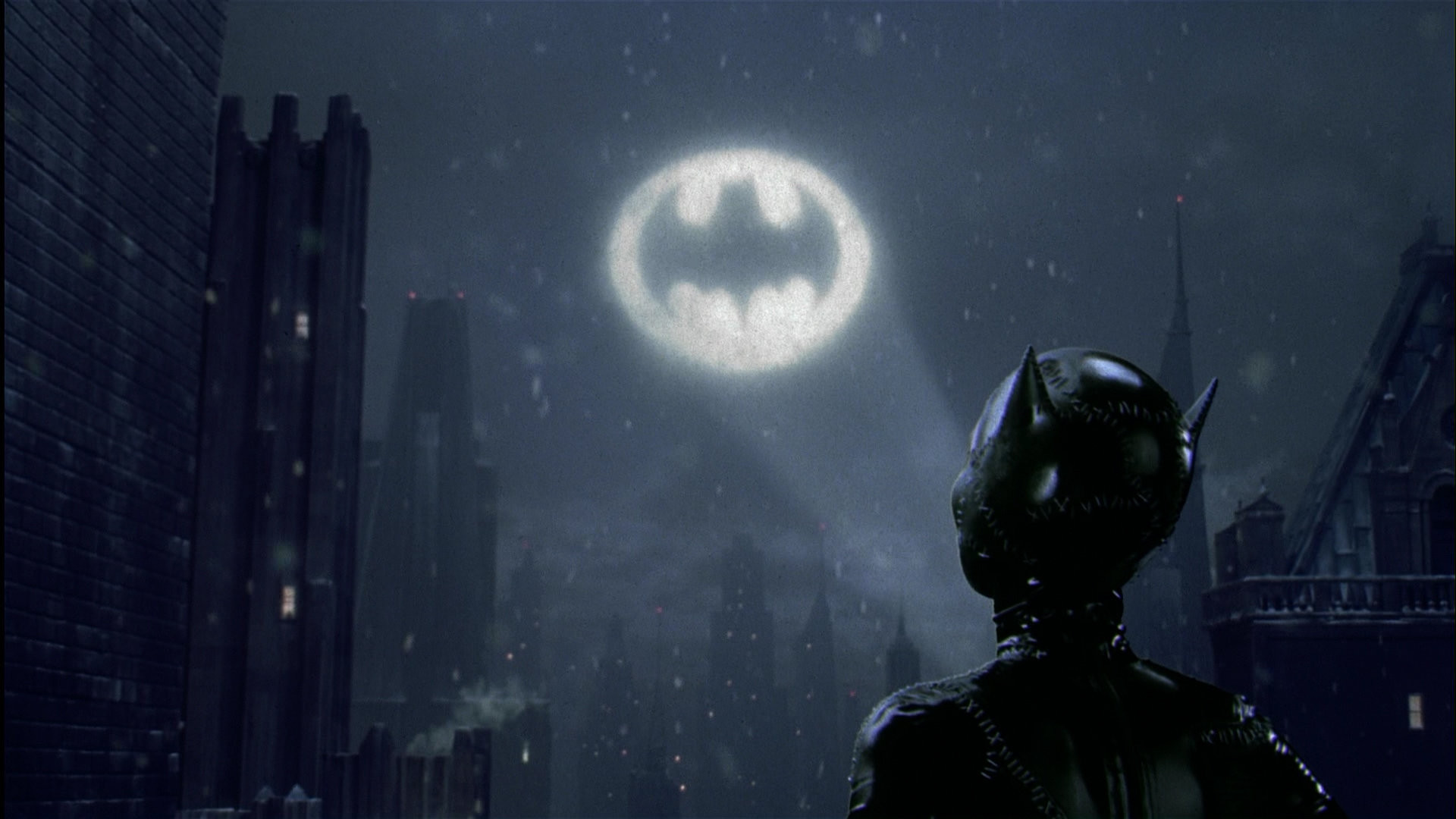From the Chicago Reader (June 26, 1992). — J.R.
BATMAN RETURNS
* (Has redeeming facet)
Directed by Tim Burton
Written by Daniel Waters and Sam Hamm
With Michael Keaton, Danny DeVito, Michelle Pfeiffer, Christopher Walken, Michael Gough, Pat Hingle, Michael Murphy, Cristi Conaway, and Andrew Bryniarski.
Even the title of Batman Returns is something of a lie, referring not to the fictional world of the story — where Batman can’t be said to return because he’s never been away — but to the dent this sequel is supposed to make in our lives. But how much of a dent can it make when it has virtually no characters, no plot, no fictional world, no mise en scene, no ideas, no developed feelings, no inspiration, no adventure, no sense of inner necessity beyond its status as an investment and marketing tool? It’s arrested development on every possible level.
Like everyone else who squeezed into Webster Place’s after-midnight shows on opening night, I was primed for some sort of revelation, however minor. It didn’t have to be elation; a good dose of mean-spirited negativity might have sufficed. I was ready for anything that could qualify as a mood changer — or barring that, a simple harking back to the original Batman, which had plenty of flaws but at least could boast the demonic vigor of Jack Nicholson’s Joker and his nihilistic media crimes, and a certain obsessional uniformity of mood and decor. For quite some time I told myself that there was something charming about this movie’s klutzy sense of uncertainty about itself, which I was interpreting as proof of its sincerity. Giving it the benefit of every doubt, I conceded that arrested development might be a viable theme as well as a condition for a movie addressed largely to teenagers. But by the end I felt I’d been sold a souvenir booklet, not a finished movie, and many of the teenagers seated around me looked as if they felt similarly shortchanged, if not exactly outraged.
One wants to like Batman Returns with a sense of hopeful desperation, much as one wants to believe in Ross Perot or Bill Clinton; one even agrees in advance to feel depressed about the inevitable disillusionment in the hope that it will at least offer a new kind of depression, a fresh form of doom. Indeed, some reviewers have been praising Batman Returns for having the prescience to depict a three-way mayoral race in Gotham City, as if this were a shrewd anticipation of the current presidential race. It’s always tempting for journalists to treat the chameleon moods of the moment as if they had lasting significance, but I would hazard the guess that the current assumption that Bush won’t be our next president may be as myopic as the belief that Batman Returns will fare even better than Batman at the box office. And if a three-way presidential race is still viable four months from now, it will make the apolitical nihilism of Batman Returns, which strikes me as 80s to the core, appear ridiculously out-of-date rather than up-to-the-minute. Anyway, I seriously question the political savvy of any movie so fascistically tied to the star system that it makes any notion of a general populace appear both obligatory and irrelevant, like sofa stuffing. When the Penguin conspires at one point to destroy all the firstborn in Gotham City — an ambition worthy of a Biblical plague — one doesn’t feel the slightest bit disturbed or frightened, because there are no visible signs of humanity in this picture to be destroyed, only empty symbols and faceless extras.
Nevertheless, Batman Returns and its publicists and defenders have been promising a lot, so expectations were running high at Webster Place. The gradual and irreversible depletion of these hopes was palpable by the end; no booing or jeering greeted the final credits, but I certainly heard no applause.
I didn’t mind that Michael Keaton’s Bruce Wayne/Batman was just as inexpressive as in the original, because his two major opponents — Danny DeVito’s Oscar Cobblepot/the Penguin and Michelle Pfeiffer’s Selina Kyle/Catwoman — promised to add something extra to the brew. Only at the end did it become obvious that promises are all this movie can offer; development or realization is entirely beyond its grasp. Even if one accepts the only emotions on view, teenage isolation and petulance — and given that the screenplay is by Daniel Waters, who wrote Heathers and cowrote The Adventures of Ford Fairlane and Hudson Hawk, one shouldn’t be surprised by such a narrow range — it’s hard to accept them being expressed in the rawest possible state, without even a fictional world worthy of the name to fester in or the possibility of implied emotions that might give them some wider context.
Personality is at such a premium in this movie that it feels uninhabited. Any Hollywood cartoon character you can think of, no matter how minor, has more substance than any character here. Daffy Duck is like Hamlet next to Bruce Wayne/Batman, and Foghorn Leghorn is a veritable Lear beside the Penguin; for that matter, even the headless and nameless black maid in Tom and Jerry cartoons of the 50s seems a lot more human and interesting in her variable moods than Selina Kyle.
DeVito and Pfeiffer’s characters wind up disappointing because they never go an inch beyond their rudimentary concepts, are totally devoid of surprises, and don’t even pan out as coherent or meaningful Jekyll-and-Hyde constructions; they’re simply sketchier forms of Keaton’s Bruce and Batman, with mechanical variations in gender, physiognomy, and character. (If the warring animal and human natures of the three characters are what’s at issue, as the script pedantically reiterates at every opportunity, it’s too bad that real penguins and bats count for so little in the mise en scene — and I could have used some more real cats as well.) DeVito’s makeup job is so half-baked and sloppy that without the script’s assurances that his character is supposed to have some affinity with actual penguins, one wouldn’t consider him part of any bird family. He merely looks like an overstuffed doll or straw man inspired by a badly remembered John Tenniel illustration from one of Lewis Carroll’s Alice books, and his supposedly fancy-sounding dialogue is too poorly written to help unify his character.
Pfeiffer’s Selina Kyle, a frumpy and mousy secretary to the evil industrialist Max Shreck (Christopher Walken), is purest caricature. When we first encounter her, pouring coffee for Shreck and the Gotham City mayor (Michael Murphy), she meekly offers to make a suggestion about what they’re discussing, then amends this to a request to ask a question; we never discover what this suggestion or question is, and it seems significant that we don’t care in the slightest. Our sense of Selina’s failure is supposed to be clinched by the fact that she doesn’t have a husband or a loyal boyfriend (despite the fact that she’s Michelle Pfeiffer). And when Shreck throws her out of a skyscraper window for knowing too much about him, we’re all set for her resurrection as Catwoman — a “return of the repressed” a la Sam Raimi’s Darkman and other comic-book vengeance figures. (Her self-transformation owes a lot to Tim Burton’s previous feature, Edward Scissorhands, but there’s little sign of any new thinking; it’s basically just regurgitation.)
As a neo-feminist vigilante figure Catwoman clearly has a lot of potential, but the movie strangles itself attempting to avoid realizing any shred of that potential. (Whether this is out of demographically inspired commercial calculations — such as a fear that misogynist teenage boys might be unduly upset by a genuinely feminist Catwoman — or sheer ineptitude I cannot say.) Saving a woman from a potential rapist, Catwoman takes great pains to demonstrate that she feels absolutely no solidarity with her; alternately smitten with and enraged by Batman, and both conspiratorially drawn toward and physically disgusted by the Penguin, she generally behaves with less complexity and unpredictability than the Batmobile — which tends to be a more privileged character in the movie, commanding the only halfway decent action sequence. Like many of the special effects, she seems to exist exclusively in relation to certain scenes and shots, not as an autonomous entity. Her visual design seems derived mainly from figures in two 1955 Hollywood pictures I find much more enjoyable: Shirley MacLaine’s “Batlady” in Frank Tashlin’s Artists and Models and Vivian Blaine and the Goldwyn Girls in the “Pet Me Poppa” number of Joseph L. Mankiewicz’s Guys and Dolls. (Her acrobatic hand flips seem directly traceable to Daryl Hannah’s replicant in Blade Runner.)
In referring to the “arrested development” of the other characters, I mean only their imaginative inadequacy, not any lack of emotional maturity. As with the three lead characters, the script and direction rather than the actors seem mainly to blame for their thinness. As a suave, though hardly original, villain named after Max Schreck, who played Nosferatu in the 20s, Walken is more than adequate. But when he’s called upon to show some feeling for his son Chip (Andrew Bryniarski), we can’t quite believe it because the script hasn’t prepared us. There’s a bit more fatherly feeling in Alfred (Michael Gough), Bruce Wayne’s aristocratic butler, but the archetypal setup of this relationship — quite similar to the one in Arthur and its sequel — is hardly fresh either. And Pat Hingle’s Commissioner Gordon, Cristi Conaway’s Ice Princess, and Michael Murphy’s mayor are essentially standard types used like props.
What about the sets, you may ask? The late Anton Furst may have depended rather heavily in Batman on Blade Runner and Brazil for his inspirations, but at least the results had a look of their own — German expressionist in overall orientation but distinctive enough that one might call them Furstian. By contrast, many of the “inventions” of Bo Welch — a Burton regular who also worked on Mommie Dearest, Swing Shift, and The Color Purple — seem slavishly dependent either on Furst or on specific shots in classic films (e.g., Metropolis for Shreck’s office, Citizen Kane for the gate entrance to the Cobblepot estate and the fireplace in Bruce Wayne’s mansion). The gigantic toy duck the Penguin rides through the sewer probably represents his creativity at its best — a nice touch that unfortunately bears little aesthetic relation to the other details.
The adolescent loneliness and sense of abandonment that stood at the center of Edward Scissorhands may ultimately be the only subject and emotion Burton feels prepared to cope with as a director, but there’s certainly no crime in trying to treat that subject again in all three of the leading characters here. My only complaint is that repetition of an idea when it’s only stated rather than explored is hardly the same thing as obsession, as some reviewers have been suggesting. And considering the laborious set pieces and mechanical effects that keep interrupting this monotonous theme, one wonders if it’s even been properly imagined. It’s almost as if all the elements that gave Batman its immense popularity –its pseudo-Wagnerian sense of dark myth, troubled characters, and brooding sets–have only been sketched in for the sequel, under the assumption that the audience can fill in the blanks with its memory of the first movie. On balance, I’d rather go swimming.






